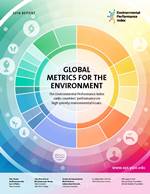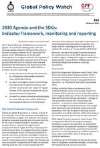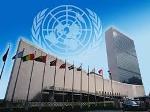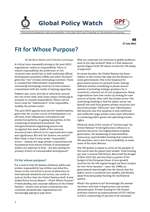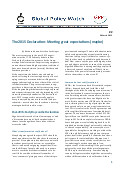Global Policy Watch
Published on Mon, 2016-08-15 14:40

A session of the HLPF. (Photo: UN)
|
The United Nations High-Level Political Forum (HLPF) met in New York from 11 to 20 July 2016. It is the central UN body addressing sustainable development, and its chief task is to monitor the implementation of the 2030 Agenda and its global Sustainable Development Goals (SDGs).
The HLPF is an intergovernmental Forum in which all 193 Member States of the United Nations can take part. In addition, representatives of major groups and civil society organizations have far-reaching options to participate. However, the Forum neither has any concrete decision-making powers nor does it perform a direct coordinating role vis-à-vis governments and UN organizations. It primarily serves the purpose of sharing information on strategies to implement the 2030 Agenda, presenting national (success) stories and critically analyzing obstacles and setbacks in achieving the SDGs.
|
Published on Mon, 2016-05-09 11:57
An “Environmental Performance Index” to be launched on May 9 at the UN claims to align itself with the Sustainable Development Goals (SDGs) but actually hides the impact of unsustainable consumption and production patterns in the North as well as the contributions of the Global South to achieving the internationally agreed targets.
The EPI (available here), now in its 10th edition, is authored by the Yale Center for Environmental Law and Policy, in collaboration with the World Economic Forum (Davos). This year’s report claims to have a “parallel approach” to the internationally agreed SDGs in its “use of quantitative metrics to evaluate policy performance” and maintains that “aligning EPI’s indicators with the SDGs provides a baseline for evaluating national performance and shows how far countries are from reaching global targets”.
|
Published on Fri, 2016-03-18 12:50
On 11 March 2016 the UN Statistical Commission agreed “as a practical starting point” with the proposed global indicator framework by which to measure progress towards the 17 goals and 169 targets of the 2030 Agenda for Sustainable Development. It recognized that the development of a robust and high quality indicator framework is a process that will need to continue over time and authorized the Interagency and Expert Group for Sustainable Development Goals (IAEG-SDGs) to continue its work
|
Published on Tue, 2015-11-24 05:53
As part of its mandate to develop an indicator framework by which to monitor the goals and targets of the post-2015 development agenda, the Inter-agency and Expert Group on SDGs (IAEG-SDGs) held its second meeting in Bangkok, 26-28 October 2015. The objective was to seek agreement on the proposed indicators for each target—keeping in mind that indicators alone can never be sufficient to fully measure progress on the goals. More specifically, it was to move provisional indicators marked yellow—needing further agreement—to either green—agreed by all parties—or grey—no agreement possible. As a result, there are now 159 green indicators (including 52 moved from yellow and 9 new ones), and 62 greys (including 28 moved from yellow plus 5 new ones).
|
Published on Wed, 2015-11-11 15:20
After a two days meeting in Bangkok, at the end of October, the statistical experts of the UN agencies have come with a controversial list of 159 “generally agreed” indicators to measure the Sustainable Development Goals approved last September by the UN.
Traditionally, development agencies have tried to summarize in a single indicator or index complex development goals. Thus, UNICEF emphasized infant mortality as a proxy indicator of its mandate to protect children, the World Bank has traditionally equated development with per capita income, and UNDP enriched that idea with its Human Development Index based on a larger but still reduced set of indicators. Those single figures were considered to correlate so closely with other relevant indicators (for example infant mortality correlates with child underweight) that they were considered as useful to represent broad trends, progress or regression, in realities that everybody understood as being complex.
|
Published on Mon, 2015-09-28 20:12
Last August 2 in New York, the United Nations agreed on the new sustainable development agenda as the guide for their global, regional and national policies over the coming fifteen years.
At the core of this new global consensus, seventeen “sustainable development goals” (SDGs) spell out a vision for a better future where poverty everywhere will be eradicated, inequalities within and between countries will be substantially reduced, and current unsustainable consumption and production patterns will be transformed.
|
Published on Fri, 2015-09-25 15:14
The Sustainable Development Goals (SDGs) negotiated painstakingly over two years by all UN Member States with thousands of public interest organizations providing their commitment and expertise have been copyrighted. And by whom? The UN you would think? But no. They have been re-branded as Global Goals (GGs) and the copyrighted by Project Everyone, a private company incorporated and registered in London.
On its own website (www.globalgoals.org), Project Everyone claims ownership of the 17 icons that it is popularizing, with active help from celebrities and the UN Secretariat itself, representing each of the 17 Goals that the heads of State and Government are endorsing this week as common objectives of humanity from here to the year 2030.
|
Published on Mon, 2015-09-14 09:24
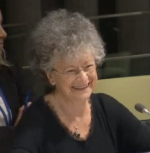
Photo: UN webtv
|
"The UN must champion a process of truth and reconciliation" in development, said Barbara Adams, on behalf of Global Policy Forum and Social Watch during a round table at the United Nations in New York. Adams emphasised that "those who have benefitted the most from the past and current model are those that need to change the most".
|
Published on Fri, 2015-07-31 18:12
A critical issue repeatedly arising in the post-2015 negotiations relates to responsibility. There is shared responsibility, the preference of rich countries who would like to shift traditional official development assistance (ODA) and other “burdens” given the “rise” of some developing countries. There is common but differentiated responsibility, stressed by developing countries to link common commitment with the reality of varying capacities.
Debates also circle, directly or otherwise, around the role of the state, with some camps continuing to promote its central responsibility. Others call for more room for “stakeholders” to be responsible—notably, the private sector.
|
Published on Wed, 2015-07-08 11:07
With pens still hovering over the Addis Ababa Action Plan, the outcome agreement for the Third International Conference on Financing for Development (FfD3), there is already a sense that for all the recent talk at the UN about ambition and transformation, it is falling short. For a financing document, the Action Plan includes an impressive number of references to issues at the core of sustainable and inclusive development, like social protection, essential services, decent work for all and sustainable industrialization. There are multiple references to consumption and production, a rebalancing of which, among the rich and the poor, will determine the future of our world.
|
SUSCRIBE TO OUR NEWSLETTER
Submit

|


